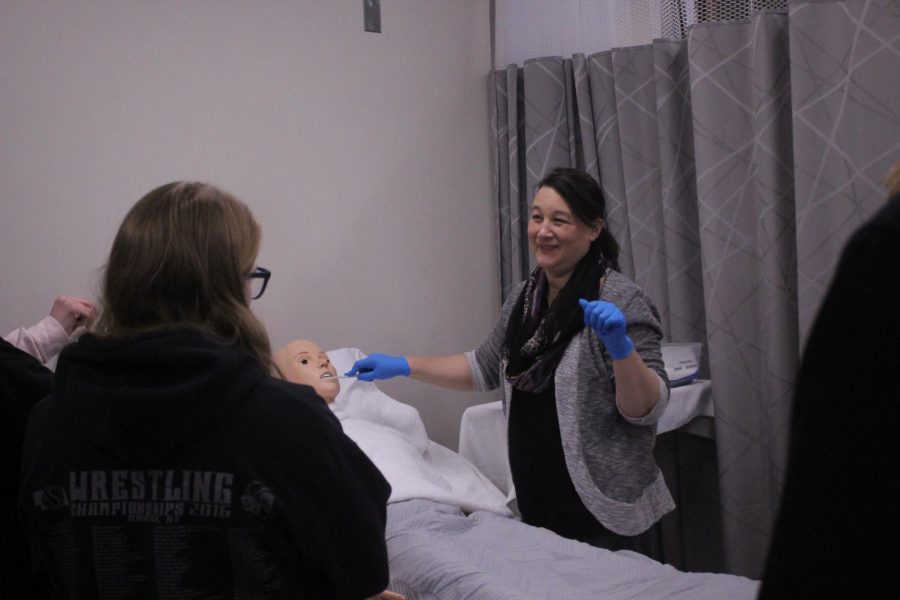CNA instructor Mrs. Wasalaski demonstrates how to brush a patient’s teeth while they are on the operating bed. “On of the biggest skills the kids learn in here is empathy,” Mrs. Wasalaski said. “Empathy makes the job easier and will carry over to the rest of life.” Each student must demonstrate his/her skills back to Mrs. Wasalaski over the course of the semester. Photo by Ethan Menning
Earning the Scrubs
Those Who Keep Hearts Beating
The constant beep of each heartbeat goes by. Slowly at first, but then the pace quickens. Panic ensues. Luckily for the patient, a nurse is almost always the first person to run in and help. Recently, a new question has arisen that would not have been dreamt of many years ago: what if there is no nurse there? What if there is no immediate help from a person who is qualified to administer help? Due to the recent shortage of nurses, students have longed for a course that could educate them in this desired and weakened field.
Instructor Mrs. Kim Wasalaski is a new hire for the district and the first to teach a certified nursing course in Gretna Public Schools. She is on a mission to raise a new generation of nurses. In her class, she provides a number of different materials and teaching methods that prepare students for the future.
“In our class, there’s never a dull moment,” Mrs. Wasalaski said. “There’s 47 skills the kids have to learn. Right now we’re going into bioscience.”
These skills will carry on to the many tasks that the CNA class does over the semester. Some of the tools that are given to students are a stethoscope to measure heartbeats and sphygmomanometers to measure the blood pressure of their patients. Students use these tools for a variety of classwork such us treating a mannequin, practicing on each other and for future clinicals.
Many of the future practitioners want to go into different occupations in the field. Luckily for them, everything that they learn in the CNA course is applicable to the scenarios of each job. Senior Andrew Wheeler, who wants to eventually be a paramedic, is able to put these skills to use.
“To get the skills for the real jobs is really helpful,” Wheeler said. “Every job has different pieces and skills required. We make it a team effort to help each other.”
All the students work to accomplish the tasks assigned in a variety of ways. From videos to the standard textbook, Mrs. Wasalaski tries to push students to be more independent and reliant on each other, rather than her.
“Once the kids get to their real jobs, they will not have me or their boss to rely on,” Mrs. Wasalaski said. “They should rely on themselves, but a big part of the medical field is working together with co-workers. That’s why I have them help each other on certain things.”
The future life-savers do apply her words of wisdom to every part of their learning. They recognize how each method will affect them positively when looking ahead. They also strive to meet the highest standards that they can and all the requirements.
“The amount of tough work we do does pay off,” Wheeler said. “It gets stressful when we have to complete all 47 skills by the end of the semester, but it is all worthwhile.”
All these skills will help prepare the students for their final exam for the class, which will reward them with a certificate of completion that can be carried over for university classes. The medical field is indeed lacking the correct practitioners but educating students of medicine will only strengthen the field’s future.
